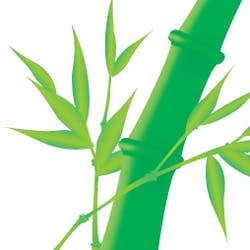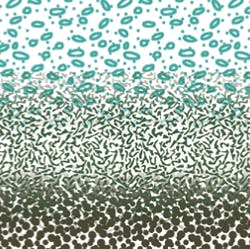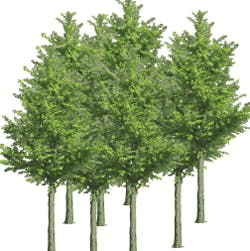It’s Green – Now Find Out What That Really Means
Bio, eco, renewable, recyclable, reclaimed, and sustainable: These are just a few of the green terms used to spice up manufacturers' product descriptions. Feel like you're being fed a mouthful of greenwash? You might be.
A solid understanding of green-product attributes will help you ask the right questions, identify those "too-good-to-be-true" claims, and make informed (and green) purchasing decisions.
You don't have to know everything - you just need to know what to ask. Below are some of the most commonly used phrases and terms in literature on green products. Depending on your involvement in product specification and your awareness of the green-building movement, you may find yourself nodding along as you read - or you may be exploring new territory. Each term or phrase is defined to give you a better understanding of some of the characteristics and qualities of green products. (Points awarded by the U.S. Green Building Council's LEED-NC, LEED-CI, and LEED-EB O&M programs are also noted.) These are in no way the only characteristics you should take into consideration, though.
Today, if you evaluate products based on a single green attribute, you could be overlooking manufacturing processes, carbon emissions resulting from transport, disposal pathway, etc. To prevent these oversights, life-cycle assessment (LCA) takes a holistic approach to evaluating environmental impact. "Being focused on the big picture rather than one tiny detail in the entire product is a good way to look at [product selection]," says Paul M. Firth, vice president, technology, The Green StandardTM, Chapel Hill, NC.
Manufacturers and service providers are responsible for conducting LCAs and making that data available. Widespread implementation of LCA is still a long way off, though, which makes it difficult to compare apples to apples. In the meantime, consider using LCA tools to help compose a list of questions to ask manufacturers and distributors (see the sidebar for a list of LCA-related resources). The ASTM E2129-05 Standard Practice for Data Collection for Sustainability Assessment of Building Products can be equally helpful.
As you gather information about certain products, remember to look for certification to validate environmental claims. "If manufacturers say, ‘Oh yeah, we do that,' say, ‘Great, show me the documentation,' " advises Eden Brukman, research director, Cascadia Region Green Building Council, Portland, OR. (See the list of certification programs below.)
Life-Cycle Assessment: The Stages of a Product's LifeJana J. Madsen ([email protected]) is managing editor at Buildings magazine.
|
If you want to find out how valid a manufacturer's claim is, get proof of it. "Significantly increased market demand for serious green-product information has led, ironically, to exponentially more greenwashing. What building owners and facility professionals can do is require manufacturers to produce third-party-certified, product-performance information," recommends Deborah Dunning, founder and president, The Green StandardTM, Chapel Hill, NC. Be leery of self-certified products. "That's like asking the fox to watch the henhouse," adds Ross G. Spiegel, an architect and associate at Shelton, CT-based Fletcher Thompson, and coauthor of Green Building Materials: A Guide to Product Selection and Specification. And, if you don't know what the certification means, find out. "Understand the relevance of the certifications and the meanings of the words, and don't be afraid to ask follow-up questions and to ask for documentation as proof," says Eden Brukman, research director, Cascadia Region Green Building Council, Portland, OR. Some of the industry's most recognized and respected certification programs follow ... CRI Green Label and Green Label Plus ENERGY STAR® FSC Certified GREENGUARD Certification Green Seal Certification Scientific Certification Systems (SCS) |
Recycled content | Rapidly Renewable Material | Biodegradable | Low or No VOCs | Sustainably Harvested
Related terms: recyclable, post-industrial (also known as pre-consumer), post-consumer
Recycling has become more sophisticated over the last 2 decades, moving well beyond office paper and soft-drink bottles. "Just about anything out there today is recyclable," says Firth. After reading a claim of recyclability, Firth recommends asking the supplier, "Is it actually being recycled?"
According to the U.S. Federal Trade Commission's (FTC) Guides for the Use of Environmental Marketing Claims, "A product or package should not be marketed as recyclable unless it can be collected, separated, or otherwise recovered from the solid waste stream for reuse, or in the manufacture or assembly of another package or product, through an established recycling program." In other words, if it can be recycled, but the facilities and technology to do so aren't readily available, then a claim of recyclability is deceptive.
The FTC also advises manufacturers to disclose which pieces of a product or its packaging (when mixed with non-recyclable components) are recyclable. If it's not clear to you what can be recycled (and where), ask.
There are two types of recycled content: post-industrial (also referred to as pre-consumer) and post-consumer. "Post-industrial recycled content means that the scraps and materials that are leftover from the manufacturing process are reused in some way," says Ross G. Spiegel, an architect and associate at Shelton, CT-based Fletcher Thompson, and coauthor of Green Building Materials: A Guide to Product Selection and Specification. The Center for Resourceful Building Technology (part of the National Center for Appropriate Technology) explains: "Typically, recycling post-industrial material is thought of as less environmentally beneficial since it indirectly encourages inefficient manufacturing processes that produce waste." For this and other reasons, post-consumer recycled content (material that has gone through its useful life) is valued more than post-industrial content.
Government agencies aren't strangers to the U.S. Environmental Protection Agency's Comprehensive Procurement Guidelines, a list of products that must contain recycled content when purchased by federal, state, and local agencies (per Executive Order 13101). But, facilities professionals managing other types of buildings can also benefit from this information - especially the construction products (insulation, carpet, latex paint, roofing, etc.) and recommended percentages of recovered-materials content.
Questions to Ask:
-
Is any portion of this product, its components, or the packaging recyclable? If yes, what portions?
-
Are there facilities available to recycle the product, its components, or the packaging?
-
Does this product contain recycled content? If yes, what's the percentage of both post-consumer and post-industrial content?
LEED-NC: 2 points (Materials & Resources Credits 4.1, 4.2).
LEED-CI: 2 points (Materials & Resources Credits 4.1, 4.2).
LEED-EB O&M: 5 points (Materials & Resources Credits 1.1-1.3; 2.1, 2.2).
Related terms: bio-based, alternative agricultural, non-cellulose materials
As awareness about the problem of deforestation has increased, so has interest in rapidly renewable (or bio-based) materials. They provide an alternative to products made of fossil-fuel-based plastics and old-growth lumber - and, when specified, purchased, and installed, can help reduce your building's impact on the environment. "If it's rapidly renewable, which the USGBC defines as regenerating in a 10-year timeframe or less, then you've got a much faster source of raw materials than other natural resources, which may take hundreds of years," explains Brukman. "A rapid growth cycle, however, is only one aspect to consider for a product to be a green option. It is also important to understand how the product is farmed, such as pesticide use, or if a rich ecosystem was cleared to make way for a monoculture plantation. Labor conditions also come into question."
Bamboo is one of the most popular non-wood alternatives. According to the Anaheim, CA-based World Floor Covering Association, this fast-growing grass is ready to harvest in 3 to 5 years and helps prevent soil erosion on hilly terrain due to its dense root mass. Offered in planks like other hardwood flooring, bamboo has been embraced as a more sustainable floorcovering option. "It went from being something that nobody used to an environmentally friendly product that almost everybody wants to use because it's strong, light, and grows back in record time," says Spiegel.
Linoleum composed of natural ingredients (i.e. linseed oil, cork, limestone, wood flour, and tree resins) is another floorcovering option containing renewable materials. Cork, which is made from the bark of a cork oak tree, is another. Wheatgrass, sorghum, wool, sisal, hemp, straw, cotton, and sunflower seeds are other bio-based substances finding their way into carpets, textiles, plywood, and insulation.
Aside from the inherent benefit to the environment, selection of products made of rapidly renewable and natural materials results in healthier indoor air quality. "If you don't have unknown synthetics in the building, then the behavior day to day in terms of the out-gassing of VOCs, as well as in a fire or flood event, are bound to be less onerous," adds Dru Meadows, principal at Tulsa, OK-based theGreenTeam Inc. and coauthor of Green Building Materials: A Guide to Product Selection and Specification.
Questions to Ask:
-
What percentage of content in the product is bio-based?
-
What is the regeneration/harvest cycle of the rapidly renewable material in this product?
LEED-NC: 1 point (Materials & Resources Credit 7).
LEED-CI: 1 point (Materials & Resources Credit 6).
LEED-EB O&M: 5 points (Materials & Resources Credits 1.1-1.3; 2.1, 2.2).
Related terms: degradable, photodegradable, compostable
The next best thing to recycling is biodegradability. If the product or its components cannot be reused and must be disposed of, their ability to decompose bears consideration. "Plastics don't break down ever, so a calculator made from plastic that we threw away in the 1980s will be found by future generations, hundreds of years from now, almost intact," says Firth.
According to the FTC's Guides for the Use of Environmental Marketing Claims, promotion of biodegradability, degradability, or photodegradability should only be made when the product or package will "decompose into elements found in nature within a reasonable, short period of time after customary disposal."
Photodegradability is a term used to describe a material that breaks down when exposed to sunlight. When purchasing a product that is marketed as degradable, be sure to ask "how" and "where." "If it breaks down as a result of UV exposure and it gets thrown into the landfill with trash covering it, it's not going to decompose," says Brukman.
In some cases, it may be best to seek out commercial/industrial compost centers in your area for the disposal of biodegradable materials. "When a biodegradable component goes into a typical landfill, it's normally not friendly for biodegradable conditions," explains Firth, "meaning that there are certain conditions that have to be in place or met for a component to biodegrade properly."
You may see the word "compostable" in product information occasionally. A manufacturer's claim that a product or its packaging is compostable indicates that it will degrade into usable, safe compost (such as a soil-conditioning material or mulch) at a facility devoted to that purpose. Brukman points to Portland's commercial composting and the employees at the Office of Sustainable Development as an example of how to deal with biodegradable materials. "They can take the unknown out of how people should manage their waste," she says.
Products with a one-time use, such as wallcoverings and eating utensils, have already begun exploring biodegradable ingredients. "It's a technology that's there. It's real, and it's possible. It's just a matter of getting the biodegradable materials to substitute in both performance quality and price for the materials that we typically use today," says Firth.
Questions to Ask:
-
Is any portion of this product, its components, or the packaging biodegradable? If yes, what portions?
-
Where should it be disposed of?
-
Are special conditions required for the material to decompose?
LEED-NC: No points are awarded for the use of biodegradable products.
LEED-CI: No points are awarded for the use of biodegradable products.
LEED-EB O&M: No points are awarded for the use of biodegradable products.
Related terms: sick building syndrome, off-gassing, out-gassing, SVOCs
Volatile organic compounds (VOCs) are chemical substances that emit (a.k.a. off-gas or out-gas) hazardous airborne gas and diminish the quality of indoor air. VOCs, as identified by the Healthy Building Network in the Pharos Project, are carcinogens, mutagens, reproductive toxicants, teratogens, endocrine disruptors, and highly acute toxicity chemicals (CMRTEs). Formaldehyde is the most widely recognized VOC. "There are cases of people who suffer from multiple chemical sensitivities and get violently ill from any of these compounds," Spiegel says.
Unfortunately, VOCs are found in a broad range of construction products, including paints, sealants, adhesives, carpet, fabrics, and composite wood. The good news, though, is that manufacturers are working feverishly to find new formulas and bring safer products to market. The best evidence of this is in the proliferation of low- and no-VOC paint.
Check a product's Material Safety Data Sheets (MSDSs) to find out about the potential impact of the product on indoor air quality. According to the U.S. Occupational Safety & Health Administration, an MSDS identifies hazards, provides toxicological data, and discloses ingredients or composition.
While investigating purchase options, don't simply examine the product. Think about installation and any other substances or materials required for use. Consider this: "Once you have an enclosed indoor environment, if you're putting on finish materials inside your tight envelope, the volatile organic compounds within a product will start off-gassing into your recently finished space," says Brukman. For example, will the stain used on wood molding emit VOCs? Will the adhesive applied in a carpet installation do the same?
South Coast Air Quality Management District and the U.S. EPA's National Volatile Organic Compound Emission Standards for Consumer Products provide VOC-content limits. Also look to see if a product has third-party certification from an organization that tests for emissions.
Products that do not emit VOCs promote a healthier indoor environment for building occupants. In other words, the best way to protect individuals from the effects of hazardous chemicals is to avoid them altogether.
Questions to Ask:
-
Does this product contain or emit any known VOCs?
-
Has the product been tested by a third party to verify a safe level of emissions?
-
Does the product require any substances for installation or use that contain VOCs?
-
Can I review the product's MSDS?
LEED-NC: 4 points (Indoor Environmental Quality Credits 4.1, 4.2, 4.3, 4.4).
LEED-CI: 5 points (Indoor Environmental Quality Credits 4.1, 4.2, 4.3, 4.4, 4.5).
LEED-EB O&M: No points are awarded for the use of low- or no-VOC products.
Related terms: FSC certified, sustainable forestry, deforestation, certified wood
Deforestation contributes to global warming and often destroys ecosystems that support certain plant and animal species. Sustainable forest management, which involves slowing the rate of harvesting, is a step toward preserving forests for future generations.
According to the World Resources Institute (WRI), forest certification emerged in the ‘90s as an approach to sustainable forest management. Today, the organization reports that 7 percent of the world's forest area is certified. The most widely recognized certification organization is the Forest Stewardship Council (FSC).
Wood bearing the FSC logo has undergone a rigorous certification process. "The Forest Stewardship Council is a rating organization that has established protocols that landowners and forest growers use," explains Spiegel. Once foresters express interest in certification, they establish a program for the harvesting and growth of the forests on their land, which is then validated by the FSC.
If a building product you're considering for purchase makes a claim that it includes sustainably harvested wood, ask if it's certified by FSC or another organization. The Yale Program on Forest Policy and Governance, in its Sept. 16, 2007, Assessing USGBC's Forest Certification Policy Options summary report, identifies FSC and the following organizations as the forest-certification programs of most relevance to the U.S. building industry:
-
American Tree Farm System.
-
Canadian Standards Association's Sustainable Forest Management System.
-
Sustainable Forestry Initiative.
-
Programme for the Endorsement of Forest Certification.
Spiegel explains sustainably harvested wood by saying, "It's basically material that has been grown in an environmentally friendly way so [foresters] are not cutting down an old-growth forest to make a door or cabinets. The plan usually includes replacing the material in the forest as it's being harvested." The manufacturers of products containing sustainably harvested wood should be able to report on its Chain of Custody, defined by the FSC as "the channel through which products are distributed from their origin in the forest to their end use."
Questions to Ask:
-
Does this product contain sustainably harvested wood? If yes, what percentage?
-
Was the wood certified by the FSC or another forest certification program?
-
Can you provide Chain-of-Custody information?
LEED-NC: 1 point (Materials & Resources Credit 7).
LEED-CI: 1 point (Materials & Resources Credit 7).
LEED-EB O&M: 5 points (Materials & Resources Credits 1.1-1.3; 2.1, 2.2).






